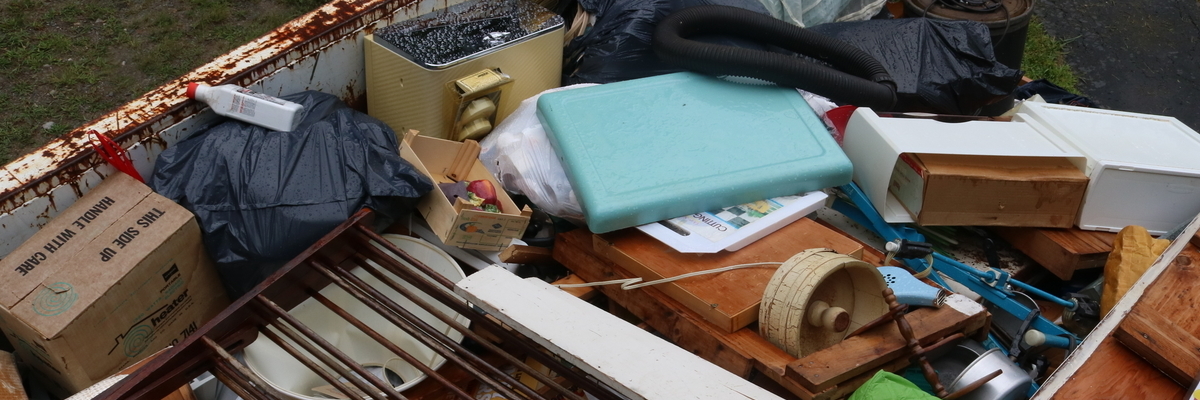By Jill Roberts / August 17, 2019
This week I walked through a home that recently went on the market. It’s owner, an elderly woman in her 90s moved into a convalescent home. She lived independently in the home since her husband passed away some 15 years ago. Their one child, now in his late 60s, is mentally disabled and resides in a nearby group home. With no other close surviving relatives, an attorney has the responsibility of clearing out and selling the house.
A decent sized ranch that served as the family’s homestead since the early 50s, its walls remained draped with family portraits, and held stories soon to be left untold. The large furniture and valuables had been removed, but strewed about the house in haphazard piles was a timeline of historical artifacts. Personal memorabilia, trinkets, and household goods; An array of “stuff” that once served a purpose or held meaning to the family. Now, waiting its fate by an unrelenting stranger.
We’ve all heard the phrase, “You can’t take it with you,” and we presume someone will want our crap when we’re gone; But it needs to be made available to prospective recipients in order for that to be made possible. In this particular case, many items had already been tossed in a dumpster, which was full to the brim. Some items still in the original packaging, and many more with a remaining useful life. “Shameful,” I thought to myself, as I considered coming to the rescue of an antique metal bread box.
I’m not criticizing the choice of the person handling the estate. The task of relocating a lifetime’s contents of a house is enormous, and without family that might have an attachment to the objects, I imagine a dumpster was the most logical and economical solution. Still, I couldn’t help but think there was a better option for relocating the items that would also pay respect to a family’s lifetime of collected treasures.
The next morning I reached out to a friend who owns “Clutter Conscious,” a company in northwest Connecticut that offers decluttering and organizing services. I’ve known the owner, Beth Murphy, for a number of years, and she’s passionate about finding unwanted items a second chance at life. She works alongside clients in a dignified manner to assist in the process of repurposing, reusing, and relocating personal belongings. Maybe I couldn’t save this family’s wares, but I could prepare a solution for myself or others who may find themselves in a similar circumstance.
Below are the tips she offered for re-homing unwanted items:
Find a good estate company. A good estate company will have the passion for finding leftover items a second chance at life. Through estate sales, online auctions and donations, the amount that will end up in a landfill can be significantly reduced. An estate company typically keeps 40% of the sales, but the items will end up in the hands of someone who can use them.
Leave unwanted items at the curb. People like to tinker; Rugs can be steamed cleaned; Vacuum cleaner parts are a big seller on eBay; Old furniture can be painted and repurposed. Snap a picture of what you’re leaving at the curb and share it on social media. You’d be surprised how fast it disappears.
Offer items on the “Buy Nothing.” Facebook Group. The Facebook group, “Buy Nothing,” is part of a national social movement, The Buy Nothing Project, that encourages and provides a forum for people to give what they’re not using to someone in their community who can use it, and receive items in the same way. The movement promotes random acts of giving and kindness, which benefits everyone. For more information check out the buynothingproject.org.
Donate items to local thrift stores. Volunteers at thrift stores are happy to receive unwanted items. The donations help the community as well as the local charities they support. Some charities, like the Salvation Army, will even drive to the home to pick up unwanted items.
Some Senior Centers accept unwanted medical items. Medical items can be expensive, especially for the uninsured. Some Senior Centers will accept unwanted medicals items that they in turn give out freely to those who can use it. Call first to see what they accept as each Senior Center will be different.
Find a drive or coordinate one. Community soup kitchens collect shoes, for example, and pet shelters are always looking for blankets. Winter coat drives are popular in the fall and winter. If you can’t find a drive, consider coordinating one that benefits a local charity of your choice.
Seek out the help of a professional organizer. Businesses like, Clutter Conscious, understand the emotional impact of decluttering or downsizing, especially with the elderly or those who are grieving. They work closely with clients to thoughtfully find appropriate ways to relocate personal items.
At least for me, there’s a satisfaction in seeing someone’s appreciation over receiving something that I once found useful or enjoyable. Knowing a once meaningful possession will breath new life again, and be appreciated in a similar way is sort of a passing of the torch. Although I couldn’t save every usable item in the dumpster, I did end up rescuing the bread box, which turned out to be circa the 1960s; It’s pretty cool and even better, it has a story attached.

